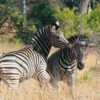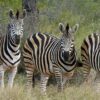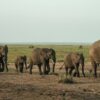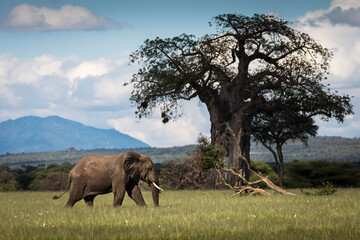Discover the Unique Facts of Tarangire National Park
Explore Tarangire National Park, home to majestic elephants, ancient baobabs, and diverse wildlife. A must-visit gem in Tanzania’s safari circuit!
Planning a Tanzania safari? You’ve likely heard of the Serengeti and Ngorongoro Crater. But what if I told you there’s a hidden gem that offers some of the most spectacular wildlife viewing in Africa? Let’s talk about Tarangire National Park. This park is a world of giant baobab trees and even bigger elephant herds. In this guide, we’ll cover everything you need to know about Tarangire National Park, from its unique facts to planning your perfect trip.
What is Tarangire National Park Famous For?
So, what sets Tarangire apart from other Northern Circuit parks? It’s a combination of unique landscapes and incredible wildlife density, especially during the dry season. Imagine a place where ancient baobab trees tower over the savanna and the ground trembles with the movement of elephant herds. That’s Tarangire for you.
The Land of Giants: Elephants and Baobabs
The park is most famous for two things: its massive elephant population and its iconic baobab trees. Tarangire is home to one of the largest concentrations of elephants in East Africa. During the dry season, you can see herds of up to 300 elephants gathering along the Tarangire River. It’s an unforgettable sight. These gentle giants share the landscape with thousand-year-old baobab trees, creating a prehistoric and magical atmosphere.
The Lesser-Known Migration
While the Serengeti has its Great Migration, Tarangire hosts its own impressive, albeit smaller, wildlife migration. From June to October, when water becomes scarce elsewhere, about 250,000 animals migrate to the park in search of the life-giving waters of the Tarangire River. This includes vast herds of wildebeest, zebras, and gazelles.
Pro Tip: To see the giant elephant herds at their most impressive, plan your visit during the peak dry season (August to October) when they congregate in huge numbers around the river.
Amazing Things About Tarangire National Park
Beyond the elephants and baobabs, Tarangire is filled with wonders that make it a truly special destination. Have you ever seen a lion climb a tree? You just might here. The park’s diverse ecosystems support a wide array of fascinating animal behaviors and rare species.
Tree-Climbing Lions and Pythons
While Lake Manyara is more famous for its tree-climbing lions, the lions in Tarangire have also picked up this unusual habit. You might spot them lounging on the branches of sausage trees, escaping the heat of the day. The park is also known for its tree-climbing pythons, a rare and thrilling sight for any safari-goer.
The Silale Swamp
This massive swamp is a critical part of the park’s ecosystem. In the dry season, it acts like a giant sponge, holding onto water and providing a lush, green oasis for wildlife when the rest of the landscape is parched. It’s a fantastic spot to see elephants, buffalo, and a variety of water birds.
Pro Tip: Ask your guide to take you to the southern end of the park. It’s less crowded and offers a more remote and authentic safari experience, especially around the Silale Swamp.
Why Go on a Tarangire National Park Safari?
With so many safari options in Tanzania, you might be wondering why you should choose Tarangire. The answer is simple: it offers an uncrowded, authentic, and diverse wildlife experience. It’s a place where you can feel a deep connection to the African wilderness.
Fewer Crowds, More Wildlife
Compared to the Serengeti or Ngorongoro Crater, Tarangire receives fewer visitors. This means you can often enjoy incredible wildlife sightings all to yourself. Imagine watching a leopard stalk its prey without a dozen other vehicles around you. That’s the kind of intimate experience Tarangire provides.
A Birder’s Paradise
Are you a bird lover? Then you’re in for a treat. Tarangire boasts over 550 bird species, making it one of the best birding destinations in Tanzania. From the endemic yellow-collared lovebird to the massive Kori bustard (the world’s heaviest flying bird), the avian life here is simply stunning. The variety of mammal species and bird species is truly remarkable.
Pro Tip: For the best birdwatching, visit during the wet season (November to May). The park is lush and green, and migratory birds from Europe and Asia are present.
Tarangire National Park History and Size
Every park has a story, and Tarangire’s is one of conservation and natural wonder. Understanding its background can deepen your appreciation for this special place.
The Meaning of Tarangire
The park gets its name from the Tarangire River, which flows through it. The name is a combination of two words from the Mbugwe language: “Tara,” meaning river, and “Ngire,” meaning warthog. So, Tarangire is the “River of Warthogs.”
Tarangire National Park Size
Established in 1970, Tarangire National Park covers an area of 2,850 square kilometers (1,100 square miles). While not the largest park in Tanzania, its strategic location within the greater Tarangire-Manyara ecosystem makes it a vital corridor for migrating wildlife.
Pro Tip: When looking at a Tarangire National Park Map, you’ll see the river running through the heart of the park. Focus your game drives along this lifeline for the most concentrated wildlife viewing.
Tarangire National Park Animals: What Can You See?
So, what animals can you see in Tarangire? The park is teeming with life. While it’s most famous for elephants, the diversity of wildlife is astounding, offering incredible Tarangire National Park photos at every turn.
The Big (and Small) Five
Tarangire is home to four of the “Big Five”: lions, leopards, elephants, and buffalo. Rhinos are unfortunately absent. However, the park is a stronghold for other fascinating creatures. Look out for the rare fringe-eared oryx and the long-necked gerenuk, two antelope species not easily found elsewhere.
Predators and Prey
With a healthy population of prey animals, predators thrive here. You have a good chance of spotting lions, leopards, and cheetahs. The park is also one of the few places in northern Tanzania where you might glimpse the endangered African wild dog.
Pro Tip: Don’t just focus on the big animals. The park’s termite mounds are ecosystems in themselves, often housing dwarf mongooses. Keep an eye out for these curious little creatures!
Best Time to Visit Tarangire National Park
Timing is everything when it comes to a safari. The experience in Tarangire changes dramatically with the seasons, so when should you go?
The Dry Season (June – October)
This is hands-down the best time for wildlife viewing. The Tarangire River becomes the only major water source, attracting thousands of animals from the surrounding areas. The vegetation is sparse, making it easier to spot wildlife.
The Wet Season (November – May)
The park transforms into a lush, green paradise. While many animals disperse, this is the best time for birding, as migratory species arrive. It’s also the calving season for many herbivores, meaning you might see lots of baby animals. Plus, you’ll find lower prices and fewer tourists.
Pro Tip: If you’re visiting in the “green season,” be prepared for afternoon showers. A waterproof jacket is a must, but the rain rarely lasts all day.
How Many Days to Spend in Tarangire?
This is a common question for travelers planning their Tanzania safari itinerary. How much time is enough to truly experience this park?
The Ideal Duration
We recommend spending at least two to three days in Tarangire. A single day trip can feel rushed and only allows you to explore the northern section of the park. Two or three days give you time to venture further south, where the landscape is more remote and the crowds are thinner.
Combining with Other Parks
Tarangire is a key part of the Northern Circuit. A popular itinerary combines 2 days in Tarangire with trips to Lake Manyara, the Ngorongoro Crater, and the Serengeti. This gives you a taste of the diverse ecosystems across northern Tanzania.
Pro Tip: Consider a fly-camping experience for one night. It’s an adventurous way to sleep out in the bush (with an armed guard, of course) for a truly immersive wilderness experience.
Tarangire National Park Tanzania Location and Travel
Getting to Tarangire is straightforward, making it an easy addition to any northern Tanzania safari itinerary.
Distance from Arusha to Tarangire National Park
The park is located about 120 kilometers (75 miles) southwest of Arusha, the main safari hub in northern Tanzania. The drive takes approximately 2-3 hours on a paved road, making it an accessible first stop on your adventure.
Getting There
Most visitors arrive by road with a safari operator as part of a larger package. You can also fly into one of the park’s airstrips via a small charter plane from Arusha or the Serengeti, offering stunning aerial views of the landscape.
Pro Tip: If driving from Arusha, stop at one of the local markets along the way to buy some fresh fruit and experience a slice of local Tanzanian life.
Tarangire National Park Fees 2025, 2026 and Safari Costs
Budgeting for a safari can be complex. Here’s a breakdown of what to expect for your Tarangire adventure.
Tarangire National Park Fees 2025, 2026
As of late 2025, the park entrance fee for non-resident adults is around $59 per person for a 24-hour period. Children have a reduced rate. These fees are set by the Tanzania National Parks Authority (TANAPA) and are subject to change.
How Much Does a 7 Day Safari Cost in Tanzania?
The Tarangire National Park Tanzania cost will vary greatly. A 7-day safari in Tanzania can range from $2,000 per person for a budget camping trip to over $7,000 per person for a luxury lodge safari. Tarangire national park tanzania packages price depends on accommodation, transport, and season.
Pro Tip: Book a package tour. Most Tarangire national park tanzania packages include accommodation, park fees, a vehicle, a guide, and meals. This is often more cost-effective and much easier than arranging everything yourself.
Is Tarangire or Serengeti Better? Everything You Need to Know
This is a classic safari dilemma. Both parks are incredible, but they offer different experiences. Let’s break it down.
Tarangire: The Dry Season Marvel
Tarangire shines brightest during the dry season (June-October) when its wildlife density is second only to the Ngorongoro Crater. It’s the best place for elephant lovers and offers a more intimate, less crowded experience.
Serengeti: The Year-Round Spectacle
The Serengeti is much larger and is famous for the year-round Great Wildebeest Migration. It offers vast, open plains and iconic savanna landscapes. The sheer scale of the Serengeti is hard to comprehend.
The Verdict
It’s not about which is “better,” but which is right for you. For a shorter safari or one focused on elephants and a less crowded feel, Tarangire is fantastic. If you have more time and want to witness the grand scale of the migration, the Serengeti is a must. Ideally? Do both!
Pro Tip: If your budget or time is limited, a safari combining Tarangire and the Ngorongoro Crater offers an incredible amount of wildlife diversity in a compact area.
Frequently Asked Questions
You’ve got questions, and we’ve got answers. Here are some quick takes on the most common queries about Tarangire.
What is unique about Tarangire National Park?
Tarangire is unique for its massive elephant herds, iconic baobab trees, and the Tarangire River, which attracts a huge seasonal migration of wildlife. It offers a less crowded safari experience compared to more famous parks.
How many lions are in Tarangire National Park?
Estimates suggest there are around 700 lions within the Tarangire ecosystem. The park is designated as a Lion Conservation Unit due to its healthy and thriving lion population.
What is the Big Five in Tarangire National Park?
You can find four of the Big Five in Tarangire: lions, leopards, elephants, and Cape buffalo. Black rhinos are not present in the park.
How many elephants are in Tarangire National Park?
Tarangire has the largest concentration of elephants in northern Tanzania. The population is estimated to be over 4,000, with large herds gathering during the dry season.
What is the meaning of Tarangire?
The name comes from the Mbugwe language, combining “Tara” (river) and “Ngire” (warthog). It means “River of Warthogs.”
What is the most unique National Park?
While “most unique” is subjective, many argue Tarangire’s combination of giant baobabs, massive elephant herds, and unique species like the fringe-eared oryx makes it a top contender in Tanzania.
What is the difference between Tarangire and Serengeti?
The main differences are size, landscape, and wildlife patterns. Tarangire is smaller with a landscape dominated by baobabs and is best in the dry season, while the Serengeti is vast, known for its endless plains and the year-round Great Migration.
Is Tarangire National Park worth visiting?
Absolutely! With its unique landscape, high density of wildlife (especially elephants), and fewer crowds, Tarangire offers an incredible and authentic safari experience that is well worth a visit.
Ready for an unforgettable adventure?
Your Tanzania Safari is just a click away!
Let the experts at Thrill Bound Adventures handle all the details so you can focus on making memories. From thrilling game drives to custom-tailored Kenyan expeditions, we bring your dream trip to life.
Contact Thrill Bound Adventures today to book your next adventure!
Contact
- Mobile: +254 713 915 070
- Hotline: +254 713 915 070
- thrillboundadventuresltd@gmail.com
- info@thrillboundadventures.com









